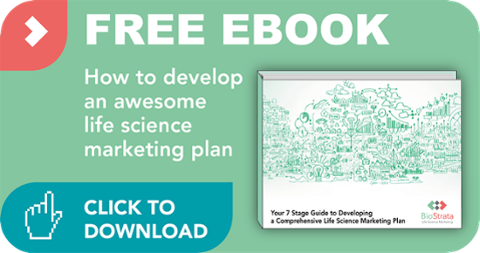Whether it’s for a blog post or long-form article, headlines are arguably the most important feature of your content. Yet, we are always surprised to see that they are so often dismissed as an afterthought. Overlooking the title of your content means you could be wasting a golden opportunity to grab the attention of your audience!
This is especially true in life science marketing. Scientists have very busy schedules, and so you need to capture their attention quickly or your content will simply fall by the wayside. If potential readers don’t have their interest piqued by your headline, they won’t click to read more. In fact, studies have shown that 80% of readers never make it to the end of the body of text, so an uninspiring title threatens to lose a reader’s attention from the start. Think about it, if this blog post was called something dreary like ‘Headline Advice’ would you be reading it right now?
So, how do you write effective life science headlines and set yourself apart from the competition? Here, we’ve formulated six top tips which will give your life science content the attention it deserves.
Blog snapshot: The title of your content is arguably its most important asset. As scientists have busy schedules, you need to ensure you can capture their attention, in order to cut through the clutter and drive action from them. Great life science headlines don't make promises they cannot keep, are created with the reader in mind, and are catchy without being too clickbait-y. To find out more about other components that make up a good marketing strategy, be sure to check out our eBook: The 7 step guide to creating a strategic marketing plan.
Tip 1: Write life science headlines that promise what will be delivered
What are the readers going to get if they choose to engage with your content? If there is confusion about what the body of the text will contain, then the headline hasn’t done its job. Make sure you spell out exactly why they need to read your article as a matter of urgency before their competition does!
Also remember that the headline must be an accurate reflection of the content. So don’t over-promise. Readers don’t want to be tricked into reading a dull and dry article; make it worth their while by captivating them with the most exciting and compelling part of your content. You will lose a reader’s trust if they are duped by a fantastic title with irrelevant content. Promise what will be delivered, and then deliver what you promised!
Tip 2: Make it catchy, but don’t lean on clickbait
The fine line between a compelling title and pure clickbait is often difficult to navigate. Websites like Buzzfeed have made clickbait headlines their raison d’être, but these kinds of tactics are not always appropriate for a scientific audience. The hyperbole that is often used to attract readers has become tiresome, and discerning readers from life science backgrounds are unlikely to be compelled by a clickbait-y headline.
Having said this, don’t be so conscious of avoiding clickbait that you are too timid with your titles: be bold! Make a statement or claim that will really entice your audience (depending on who your audience is), and create a punchy or even amusing title that also delivers on accuracy and integrity. You may need several attempts at this, which leads us nicely onto our next tip…
Tip 3: Experiment with several headlines until you find the perfect fit
Like Goldilocks and her porridge-y crime spree, try a few options until you find a headline that feels just right. Make sure these range in style and tone. One tip is to take it to two extremes: write something really forceful and provocative (one step away from clickbait) and then write the most formal and straight headline you can think of. Use these as your two poles—then fill in the rest of the spectrum.
Once you have a range of options available, you can whittle down the ones that don’t feel appropriate or assess which ones have been more effective if possible. Remember to consider the buyer persona you are aiming the content at, and which stage of the buyer’s journey they are in. By considering these factors, your headline is much more likely to resonate.
Tip 4: Make sure your content can be found
Witty and pun-based headlines may certainly humour your readers, but will search engines love them too? Search engines are the main way in which your online content will be found, so make sure you optimise for them. Consider phrasing the headline in the form of a question which your audience may ask, and make sure you include keywords and phrases that they will be using when plugging in their search terms.
There are resources available for finding the most appropriate keyword for your title, such as Moz’s Keyword Explorer and WordStream’s Free Keyword Tool. By typing in a few keywords, these tools can give you an idea of the search volume they generate.
Tip 5: Put your reader in the headline
When writing headlines for a blog on, say, life science marketing trends, it can be tempting to simply summarise the content and almost automatically generate a title. Headlines like “The latest life science marketing trends” work in terms of describing what the article will contain, but it’s important to think about the ‘why’ as well as the ‘what’. Being empathetic to the needs of your readers and asking yourself “what’s in it for them?” is key to a successful headline and allows you to target their specific needs more accurately.
So why would your readers be interested, and how can your content affect them directly? When you consider these questions, the rather bland headline above can be transformed into something much more gripping, such as: “How will the latest life science marketing trends affect your business?”.
Tip 6: Use numbers & statistics
You may have noticed we’ve used this tip in this article’s headline, and for good reason! Readers are much more likely to engage in a piece of content if it is neatly packaged into easily readable nuggets of information. A list is much more appealing than a giant block of text. So, separate your article into numbered clusters and refer to them in the headline.
Also, statistics can help vastly improve how often your content is read. In fact, it’s been shown that blog posts that contain a statistic in the headline can perform 10 times better than those without. Backing up your title with evidence improves the credibility of your content as well as giving it much more context.
If you’re looking to connect with your audience, an irresistible title is a great way to do this. By using these tips as a guide, you should be able to create inspiring life science headlines that truly resonate with your potential customers, meaning that they’re more likely to read and approve of your content. So, a headline should never be overlooked, as they have the power to turn potential customers into lifelong clients.
If you want to learn more about other components that make up a good marketing strategy, be sure to check out our eBook: The 7 step guide to creating a strategic marketing plan.





